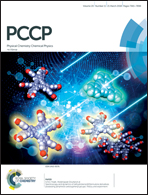The electrocatalytic characterization and mechanism of carbon nanotubes with different numbers of walls for the VO2+/VO2+ redox couple†
Abstract
Carbon nanotubes (CNTs) have been applied as catalysts in the VO2+/VO2+ redox, whereas the mechanism of CNTs for the redox reaction is still unclear. In this work, the mechanism of the VO2+/VO2+ redox is investigated by comparing the electrocatalytic performance of CNTs with different distributions. For different CNTs, the peak current density of the VO2+/VO2+ redox increases with increasing content of oxygen-functional groups on the surface of CNTs, especially the carboxyl group which is proved as active sites for the redox reaction. Moreover, the reversibility of the VO2+/VO2+ redox decreases with increasing defects of CNTs, as the defects affect the charge transfer of the catalytic reaction. Nevertheless, when a multi-walled CNT sample is oxidized to achieve a high content of oxygen functional groups and defects, the peak current density of the redox reaction increases from 38.5 mA mg−1 to 45.4 mA mg−1 whilst the peak potential separation (ΔEp) also increases from 0.176 V to 0.209 V. Overall, a balance between the oxygen functional groups and the defects of CNTs affects the peak current and the reversibility for the VO2+/VO2+ redox.



 Please wait while we load your content...
Please wait while we load your content...